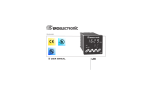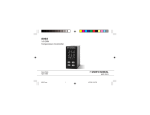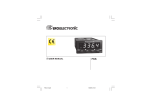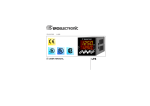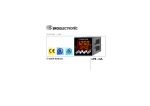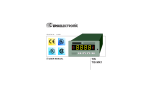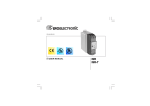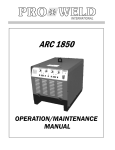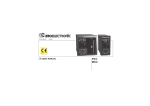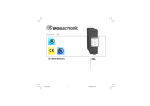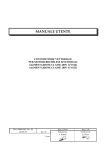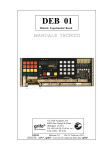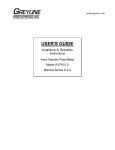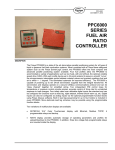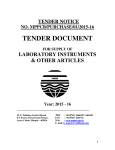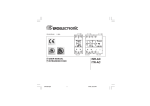Download r USER MANUAL - E
Transcript
170.IU0.TMS.000 4.3-99/D r USER MANUAL TMS INDEX MOUNTING REQUIREMENTS .......................... 1 DIMENSIONS AND PANEL CUT OUT ............... 2 WIRING GUIDE LINES ....................................... 3 PRELIMINARY HARDWARE SETTINGS ........... 8 CONFIGURATION PROCEDURE ...................... 9 OPERATIVE MODE .......................................... 14 SMART function ........................................ 14 Output power OFF ..................................... 15 Heater break down alarm .......................... 15 Direct access to the set point .................... 16 Lamp test ................................................... 16 OPERATIVE PARAMETERS ............................ 16 ERROR MESSAGES ........................................ 19 GENERAL INFORMATIONS ............................ 21 DEFAULT PARAMETERS ............................... A.1 I 5) Make sure you cannot move the case within the cut out otherwise you do not have a NEMA 4X/IP65 protection. MOUNTING REQUIREMENTS Select a mounting location having the following characteristics: 1) it should be easy accessible also on the rear side. 2) there is no vibrations or impact 3) there are no corrosive gases (sulphuric gas, ammonia, etc.). 4) there are no water or other fluid (i.e. condense) 5) the ambient temperature is in accordance with the operative temperature of the instrument (from 0 to 50 °C). 6) the relative humidity is in accordance with the instrument specifications ( 20% to 85 % non condensing). The instrument can be mounted on a panel up to 15 mm thick with a square cutout of 45 x 92 mm. For outline and cutout dimensions refer to Fig. 2. The surface texture of the panel must be better than 6,3 µmm. The instrument is shipped with rubber panel gasket (50 to 60 Sh). To assure the IP65 and NEMA 4 protection, insert the panel gasket between the instrument and the panel as shown in fig. 1. screw bracket panel screw While holding the instrument against the panel proceed as follows: 1) insert the instrument through the panel gasket, 2) insert the instrument, with the panel gasket, through the panel cut out, 3) while pressing the instrument firmly against the panel, insert the mounting bracket and slide it up to the end of the case, 4) with a screwdriver, turn the screws with a torque between 0.3 and 0.4 Nm, gasket Fig. 1 GB 1 DIMENSIONS AND PANEL CUT OUT Fig. 2 GB 2 A) MEASURING INPUT NOTE: Any external components (like zener barriers etc.) connected between sensor and input terminals may cause errors in measurement due to excessive and/or not balanced line resistance or possible leakage currents. WIRING GUIDELINES Connections are to be made with the instrument housing installed in its proper location. THERMOCOUPLE INPUT + 1 _ 3 Shield + 1 Fig. 3.A TERMINAL BLOCK (for 100/240 V AC models) _ 3 Shield Fig. 4 THERMOCOUPLE INPUT WIRING NOTE: 1) Don’t run input wires together with power cables. 2) For TC wiring use proper compensating cable preferably shielded 3) If shielded cable is used, it should be grounded at one point only. Fig. 3.B TERMINAL BLOCK (for 24 V AC/DC models) GB 3 B) CURRENT TRANSFORMER INPUT RTD INPUT RTD RTD 6 7 Current transformer 4 3 1 4 3 1 Load Fig. 5 RTD INPUT WIRING NOTE: 1) Don’t run input wires together with power cables. 2) Pay attention to the line resistance; a high line resistance (higher than 20 Ω/wire) may cause measurement errors. 3) If shielded cable is used, it should be grounded at one point only. 4) The resistance of the 3 wires must be the same. GB Fig. 6 CURRENT TRANSFORMER INPUT WIRING Note: 1) The input impedance is equal to 10 Ω. 2) the maximum input current is equal to 50 mA (50 / 60 Hz). 4 3) Use copper conductors only. 4) Don’t run input wires together with power cables. 5) Relay output and SSR drive output are both available. When a relay output is desired it is necessary to enable the SSR output and viceversa (see chapter "Preliminary hardware settings"). C) RELAY OUTPUTS AL2/HBD (OUT 3) 10 11 AL1/COOL (OUT 2) C - OUT 3 NO - OUT 3 NO/NC [see Fig.11 (J303)] OUT 2 The following recommendations avoid serious problems which may occur, when using relay output for driving inductive loads. 16 17 C - OUT 2 INDUCTIVE LOADS High voltage transients may occur when switching inductive loads. Through the internal contacts these transients may introduce disturbances which can affect the performance of the instrument. The internal protection (varistor) assures a correct protection up to 0.5 A of inductive component but the OUT 1 NC contact and out 3 are not protected. The same problem may occur when a switch is used in series with the internal contacts as shown in Fig. 8. C OUT 1 20 NO 21 NC 22 Fig. 7 RELAY OUTPUT WIRINGS The output 2 and the NO contact of the output 1 are protected, by varistor, from inductive load with an inductive component up to 0,5 A. The rating of the out 1 contact is equal to 3A/250 V AC on resistive load. The rating of the out 2 and 3 contacts is equal to 2A/250 V AC on resistive load. The number of operations is 1 x 105 at specified rating. NOTES: 1) To avoid electric shock, connect power line at the end of the wiring procedure. 2) For power connections use No 16 AWG or larger wires rated for at last 75 °C. GB Fig. 8 EXTERNAL SWITCH IN SERIES WITH THE INTERNAL CONTACT 5 In these cases it is recommended to install an additional RC network across the external contact (or close to the non protected contact of the instrument) as shown in Fig. 8. The capacity (C) and resistive (R) values are shown in the following table. LOAD (mA) C (µF) R (Ω) P. (W) OPERATING VOLTAGE <40 mA 0.047 100 <150 mA 0.1 22 <0.5 A 0.33 47 1/2 2 2 260 V AC 260 V AC 260 V AC D) LOGIC OUTPUT FOR SSR DRIVE _ 18 OUT 1 19 + _ + Solid state relay _ 14 OUT 2 (AL1/Cool.) The cable involved in relay output wiring must be as far away as possible from input or communication cables. 15 + _ + Solid state relay Fig. 9 SSR DRIVE OUTPUT WIRING. These are time proportioning outputs. Logic level 0: Vout < 0.5 V DC. Logic level 1: - 14 V + 20 % @ 20 mA - 24 V + 20 % @ 1 mA. Maximum current = 20 mA. NOTES: 1) These outputs are not isolated. A double or reinforced isolation between instrument output and power supply must be assured by the external solid state relay. 2) Relay output and SSR drive output are both available. When a SSR output is desired it is necessary to enable the relay output and viceversa (see chapter "Preliminary hardware settings"). GB 6 E) POWER SUPPLY - It shall be in close proximity to the equipment and within easy reach of the operator; - it shall be marked as the disconnecting device for the equipment. NOTE: a single switch or circuit-breaker can drive more than one instrument. 9) When a neutral line is present, connect it to terminal 12. N R (S,T) N 13 Power line from 100 V to 240 V AC (50/60Hz) or 24 V AC/DC R (S,T) 12 Fig. 10 POWER LINE WIRING NOTE: 1) Before connecting the instrument to the power line, make sure that line voltage corresponds to the description on the identification label. 2) To avoid electric shock, connect power line at the end of the wiring procedure. 3) For supply connections use No 16 AWG or larger wires rated for at last 75 °C. 4) Use copper conductors only. 5) Don’t run input wires together with power cables. 6) For 24 V AC/DC power supply, the input polarity is a do not care condition. 7) The power supply input has no fuse protection. Please, provide a fuse type T, 1 A, 250 V externally. When fuse is damaged, it is advisable to verify the power supply circuit, so that it is necessary to send back the instrument to your supplier. 8) The safety requirements for Permanently Connected Equipment say: - a switch or circuit-breaker shall be included in the building installation; GB 7 OPEN INPUT CIRCUIT PRELIMINARY HARDWARE SETTINGS These device are capable to detect leads break for TC and RTD inputs. For RTD input it shows this status as an overrange condition. For thermocouple input only, it is possible, to select the overrange indication (standard) by closing CH2 and opening SH2 or underrange indication by closing SH2 and opening CH2. SH2 and CH2 are located on the soldering side of the CPU card (see fig.12). 1) Remove the instrument from its case. 2) For out 1 and 2 it is possible to select the desired output type by setting the J304 and J305 jumpers. J304 (AL1, Cool.) 1-2 = SSR 2-3 = Relay J305 (OUT 1) 1-2 = SSR 2-3 = Relay 3) For out 2 it is possible to select the used relay contact (NO or NC) by setting J303 jumper. J303 (AL1, Cool.) 1-2 = Out NO 2-3 = Out NC Note : J303 is a soldering jumper and it is located on the soldering side of the card. CH2 SH2 1 J 303 1 3 J304 J305 J3 0 5 PZ22 R 3 01 1 R 3 03 1 4 3 Q 304 1 2 1 R 312 Q 303 L 30 1 C 301 K 3 01 PZ20 R 30 2 5 R 304 PZ21 L 30 4 J3 04 C 3 05 Q 301 4 3 C3 C312 PZ17 C 309 R30 9 C 3 08 7 + 1 C 306 I 05 B 4 TR301 J302 D3 3 U 30 1 - + C 3 07 C 310 PZ15 C 314 PZ16 L3 03 C E 1 Q 302 R 310 3 2 PZ13 R 30 6 D307 R308 R 307 D306 D301 C 30 2 I L 30 2 04 C 303 D304 U 302 R 3 05 C 31 1 D310 PZ18 2 PZ14 1 Q305 C 313 2 K 30 2 R314 R3 1 1 3 PZ19 5 J303 R 3 13 D302 Fig. 12 J301 1 1 4 D308 X Y 00 L305 PZ12 Y3 0 1 Fig 11 GB 8 3) Re-insert the instrument.. 4) Switch the instrument “ON”. The display will show COnF. NOTE : If “CAL” indication is displayed, press immediately the s push-button to return to the configuration procedure. 5) Push the FUNC push-button. The instrument will show on the lower display the parameter code and on the upper display the actual parameter value. GENERAL NOTES for configuration. FUNC = This will memorize the new value of the selected parameter and go to the next parameter (increasing order). SMRT = This will scroll back the parameters without memorization of the new value. s = This will increase the value of the selected parameter t = This will decrease the value of the selected parameter. P1 - Input type and standard range 0 = TC type L range 0 / +800 °C 1 = TC type J range 0 / +800 °C 2 = TC type K range 0 / +999 °C 3 = TC type N range 0 / +999 °C 4 = RTD type Pt 100 range -199 / +500 °C 5 = RTD type Pt 100 range -19.9 /+99.9 °C 6 = TC type T range 0 / +400 °C 8 = TC type L range 0 / +999 °F 9 = TC type J range 0 / +999 °F 10 = TC type K range 0 / +999 °F 11 = TC type N range 0 / +999 °F 12 = RTD type Pt 100 range -199 / +999 °F 13 = TC type T range 0 / +752 °F CONFIGURATION PROCEDURE 1) Remove the instrument from its case. 2) Set the internal switch V2 in open condition P2 = Initial scale value Not present when P1 = 5 Initial scale value used by the PID algorithm to calculate the input span. P2 is programmable within the input span selected by P1. When P2 has been modified, the instrument assignes to the rL parameter the new P2 value. Fig.13 V2 GB 9 P3 = Full scale value Not present when P1 = 5 Full scale value used by the PID algorithm to calculate the input span. P3 is programmable within the input span selected by P1. When P3 has been modified, the instrument assignes to the rH parameter the new P3 value. NOTE: the minimum input span (P3 - P2) is - 300 °C or 600 °F for TC input - 100 °C or 200 °F for RTD input. P4 = Output configuration H = heating HC = heating/cooling P5 = Main output type rEL = Relay output. SSr = SSR output. NOTE: Setting P5 = rEL, the C parameter will be automatically set to 20 s. Setting P5=SSr, the C parameter will be automatically set to 2 s. P6 = Cooling output type Available only when P4 = HC AIr = air OIL = oil H2O = water NOTE: Setting P6 = Air, the C2 parameter will be automatically set to 10 s and rC parameter will be set to 1.00. Setting P6=OiL, the C2 parameter will be automatically set to 4 s and rC parameter will be set to 0.80. GB 10 Setting P6=H2O, the C2 parameter will be automatically set to 2 s and rC parameter will be set to 0.40. P7 = Alarm 1 Available only when P4 = H. 0 = Not provided 1 = Process alarm 2 = Band alarm 3 = Deviation alarm P8 = Alarm 1 operative mode Available only when P7 is different from 0 and P4 = H. H.A = high alarm (outside band) with automatic reset L.A = low alarm (inside band) with automatic reset H.L= high alarm (outside band) with manual reset L.L= low alarm (inside band) with manual reset P9 = Stand by (mask) of the alarm 1 Available only when P7 is different from 0 and P4 = H. OFF = stand by (mask) disabled ON = stand by (mask) enabled NOTE: the alarm stand by function allows to disable the alarm indication at instrument start up or, for band and deviation alarms, after a set point modification. The alarm will be automatically reactivated when the initial alarm condition disappears. P10 = Alarm 2 0 = Not provided 1 = Process alarm 2 = Band alarm 3 = Deviation alarm Alarm 2 and HBD functions are in OR condition on the output 3 (see P16 parameter). P11 = Alarm 2 operative mode and reset of the HBD alarm. Available only when P10 is different from 0 or P16 is different from OFF. H.A = high alarm (outside band) with automatic reset L.A = low alarm (inside band) with automatic reset H.L= high alarm (outside band) with manual reset L.AL= low alarm (inside band) with manual reset NOTE: The HBD alarm is a low alarm but it assumes the same reset type selected for alarm 2. P12 = Stand by (mask) of the alarm 2 Available only when P10 is different from 0. OFF = stand by (mask) disabled ON = stand by (mask) enabled For other details see P9 parameter. P13 = Type of OFFSET applied to the measured value P13 = 0 the OFFSET (P14) is constant all over the range. P13 different from 0P13 is the application point of the OFFSET selected by P14 parameter. NOTE: the P13 and P14 parameters do not modify the measuring or read-out limits of the instrument so that when one of this limit has been exceeded, the instrument will show an out of range condition. GB 11 P14 = OFFSET value When P13 = 0, P 14 is programmable, in engineering units, from -20% to + 20% of the input span (see P1). When P13 ≠ 0 P14 is programmable, in engineering units, from -20% to + 20% of the P13 value. NOTE: the P14 parameter can not be set lower than -199 units. Readout. Real curve Readout. Real curve P14 P14 Adjusted curve Input P13 = 0 Adjusted curve P13 Input P15 = Threshold of the “Soft Start” function. Threshold value, in engineering units, used by the instrument for automatic enabling of the "soft start" function (timed output power limiting). At instrument start up, if the measured value is lower than the programmed threshold value, the instrument will automatically enable the output power limiter (see OLH parameter) and it maintains this limit for a time programmed by tOL parameter. At instrument start up, if the tOL parameter is equal to "InF", the P15 setting has no effect. P16 = Measure of the current consumed by the load driven by the main output (HBD) OFF = measure disabled n.O. = measure enabled during the ON period (logic status 1 for SSR output or contact NO for relay output) n.C. = measure enabled during the OFF period (logic status 0 for SSR output or contact NC for relay output) P17 = Full scale of the current transformer. Available only when P16 is different from OFF. 10 = 10 A (resolution: 0.1 A) 25 = 25 A (resolution: 1 A) 50 = 50 A (resolution: 1 A) 100 = 100 A (resolution: 1 A) P18 = Safety lock 0 = device unlocked. All the parameters can be modified 1 = device locked. No one parameters can be modified exception made for SP. From 2 to 499 = during operative mode, SP parameter can be modified and this number allows to enable/ disable the modification of all the other parameters. From 500 to 999 = SP, A1 and A2 parameters can be modified and this number allows to enable/disable the modification of all the other parameters. NOTE: After FUNC push-button pressure it will be impossible to display this value again. If you don't remember the old key, set a new value. GB 12 The configuration procedure is completed and the " on both displays. instrument will show " When it is desired to end the configuration procedure push the FUNC push-button; the display will show "COnF". -.-.-. When it is desired to access to the advanced configuration parameter, proceed as follows: 1) using s and t push-button set the 217 code. 2) push the FN push-button; the instrument will start the auxiliary configuration procedure and it will show the following additional parameters. P19 - Main output action Available only when P4 = H. r = Reverse (heating) d = direct (cooling) Note : when P4 = HC, this parameter is equal to "r". Reverse Direct Input Input t Output t Output t t P21 - Alarm 1 output action Available only when P7 is different from 0 and P4 is equal to H. r = reverse (relay de-energized in alarm condition). d = Direct (relay energized in alarm condition) P22 - Alarm 2 output action Available only when P10 is different from 0 and P16 is different from "OFF". r = reverse (relay de-energized in alarm condition). d = Direct (relay energized in alarm condition) P23 - Automatic modification of the "relative cooling gain" Available only when P4=HC. OFF = The SMART function will NOT modify the "relative cooling gain" parameter value. ON = The SMART function will modify the "relative cooling gain" parameter value. P24 - Control output maximum rate of rise This parameter allows to set the maximum rate of rise of the control output. It is programmable from 1 to 10 % of the output signal per second. Setting a value greater then 10%/s the upper display will blank and no limit is applied. P25 - Display of the protect parameter enabling/disabling. Available only when P18 is different from 0. OFF = protected parameter cannot be displayed ON = protected parameter can be displayed P26 - SMART function enabling/ disabling 0= The SMART function is disabled 1= The SMART function enabling/disabling is NOT protected by the safety key. 2 = The SMART function enabling/disabling is protected by the safety key. GB 13 P27 - Maximum value of the proportional band settable by the SMART function Available only when P26 is different from 0. This parameter may be programmed from P28 or P29 value to 99.9. P28 - Minimum value of the proportional band settable by the SMART function Available only when P4=H and P26 is different from 0. This parameter may be programmed from 1.0 % to P27 value. P29 - Minimum value of the proportional band settable by the SMART function in heating/ cooling control only Available only when P4=HC and P26 is different from 0. This parameter may be programmed from 1.5 % to P27 value. P30 - Minimum value of integral time settable by SMART function. Available only when P26 is different from 0. This parameter may be programmed from 00.1 (mm.s) to 02.0 (mm.s). P31 - Extension of the anti-reset-wind up Range: from -30 to +30 % of the proportional band. NOTE: a positive value increases the high limit of the anti-reset-wind up (over set point) while a negative value decreases the low limit of the antireset-wind up (under set point). The auxiliary configuration is finished and the instrument will show "CnF" on the upper display. OPERATIVE MODE SMART function 1) Remove the instrument from its case. 2) Set the V2 jumper (see fig. 13) in close condition. 3) Re-insert the instrument. 4) Switch on the instrument. The SMART algorithm is a NEW self-tuning function of the instrument. It is used by the instrument to calculate and set automatically the control parameters. The SMART algorithm may be ever operative; in this case it will adapt continuously the control parameter in order to perform the best control action. To start "SMART" function, depress the SMRT push-button for more than 1.5 seconds when the instrument is in NORMAL DISPLAY MODE, the SMRT indicator will start blinking or lighting according to the special function performing. When it is desired to disable the SMART function, push the SMRT push-button again, the SMRT indicator will turn to OFF. NOTES: 1) During the SMART function operation, the relative cooling gain (if present) is limited within the following ranges: Cooling element range Air 0.85 to 1.00 OIL 0.80 to 0.90 0.30 to 0.60 H2O 2) The SMART function use a derivative action equal to 1/4 of the integral action. 3) The limits of the proportional band and of the integral time settable by the SMART function are programmed by P27, P28, P29 and P30 parameter. 4) The enabling/disabling of the SMART function may be under safety key protection. 5) When SMART function is enabled, it is impossible to modify the Pb, ti and td parameter; for rC parameter see P23 parameter. The upper display will show the measured value while the lower display will show the programmed set point (we define this display condition as “normal display mode”). Note: When a ramp is applied to the set point value (see rP parameter), the displayed set point value may be different from the operative set point. When the HBD function is configured, the control output is enabled and the instrument is in normal display mode, pushing the s push-button the lower display will show the current, followed by the "A" symbol, consumed by the load driven by the main output. NOTE: the time out has no effect on this indication. When it is desired to come back to the normal display mode, push the s push-button again. GB 14 OUTPUT POWER OFF The TMS allows to turn OFF manually the output signal in order to stop the control (the instrument will operate as an indicator only). To turn OFF the output signal proceed as follows: 1) push and maintain the pressure on the s push-button 2) push FUNC push-button. 3) Maintaining the pressure on both push-buttons for more than 3 seconds; the lower display will show "OFF" and the output signal will be inhibited. When it is desired to come back to the normal control, repeat the actions 1, 2 and 3; the instrument goes automatically to the NORMAL DISPLAY MODE. NOTE: 1)The instrument memorizes the output status. 2) If the output is turned OFF when the SMART function was performing the first part of the algorithm (LED SMRT is flashing), the SMART function will be aborted and when the instrument comes back to the normal control, the SMART function will be disabled. If the output is turned OFF when the SMART function was performing the adaptive part of the algorithm (LED SMRT is lit), the SMART function will be stopped and, when the instrument comes back to the normal control, the smart function also will be activated. GB 15 HEATER BREAK DOWN ALARM This alarm allows to verify, continuously, the current consumed by the load driven by the main output and generates an alarm condition when this current is lower than a programmable threshold. To display the main load consumption, push the s push-button when the instrument is in NORMAL DISPLAY MODE. The upper display will show the measured value while the lower display will show the main load consumption (in Ampere) followed by the engineering unit (A). To come back to the normal display mode, push the s push-button. When an alarm condition is detected, the LED AL2/HB will be flashing and the relay of the out 3 (alarm 2 OR heater break down alarm) will be activated. DIRECT ACCESS TO THE SET POINT MODIFICATION The instrument allows to modify the set point value without to use the FUNC push-button. When a rapid set point modification is required, proceed as follows: 1) Pushing, for more than 3 seconds, the s or t push-button; the set point value, shown on the lower display, will start to change. 2) Using the s and t push-buttons, it is possible to set the desired value. 3) When the desired value is reached, do not push any push-button for more than 3 seconds, the new set point will become operative after 3 seconds from the last pushbutton pressure. If, during this procedure, it is desired to lose the new value, push the FUNC push-button; the instrument automatically returns to the normal display mode without to memorize the new set point. LAMP TEST When it is desired to verify the display efficiency, push t and FUNC push-buttons. The instrument will turn ON, with a 50 % duty cycle, all the LED of the display (we define this function "LAMP TEST"). No time out is applied to the LAMP TEST. When it is desired to come back to the normal display mode, push t and FUNC push-buttons again. No other keyboard function is available during LAMP TEST. GB 16 OPERATIVE PARAMETERS Operative parameter modification Push the FUNC push-button, the lower display will show the code while the upper display will show the value or the status (ON or OFF) of the selected parameter. By s or t push-button it is possible to set the desired value or the desired status. Pushing the FUNC push-button, the instrument memorizes the new value (or the new status) and goes to the next parameter. A pressure of the SMRT push-button allows to come back to the previous parameter without to memorize the new set of the actual parameter. Some parameters may be not visualized according to the specific instrument configuration. NOTE: 1) If, during operative parameter modification, no push-button is pressed for more than 10 seconds, the instrument reverts automatically to the “normal display mode” without to memorize the last parameter setting. 2) The instrument do not display all parameter but it select the parameter in accordance with: a) the instrument configuration b) P25 setting c) the proportional band setting. Param.Description SP n.rS nnn A1 A2 H1 Main set point Range: from rL to rH. Manual reset of the alarms This parameter is available only when one alarm with manual reset has been programmed. Set ON and push the FUNC push-button to reset the alarms. Software key for parameter protection. This parameter is skipped if P18 = 0 or 1. The instrument will shows the safety key status: ON = the instrument is in LOCK condition OFF = the instrument is in UNLOCK condition When it is desired to switch from LOCK to UNLOCK condition, set a value equal to P18 parameter When it is desired to switch from UNLOCK to LOCK condition, set a value different from P18 parameter. Alarm 1 threshold value This parameters is present if the alarm 1 is configured only. Ranges: - From P2 to P3 for process alarm. - From 0 to 500 units for band alarm. - From -199 to 500 units for deviation alarm. Alarm 2 threshold value For other details see A1 parameter. Alarm 1 hysteresis This parameters is present if the alarm 1 is configured only. Range: From 0.1% to 10.0% of the input span or 1 LSD. GB 17 H2 Pb HS ti td Note: If the hysteresis of a band alarm is larger than the alarm band, the instrument will use an hysteresis value equal to the programmed band minus 1 digit. Alarm 2 hysteresis For other details see H1 parameter. Proportional band. Range: from 1.0 % to 99.9 % of span for heating output. From 1.5 % to 99.9 % of span for heating/ cooling output. When Pb parameter is set to 0, the instrument performs an ON-OFF control; the ti, td, IP, C, C2, rC, OLP, OLH and tOL parameters are skipped and SMART function is disabled. Note: When SMART is enabled, the Pb parameter range is limited by P27, P28 and P29 parameters. Hysteresis for ON/OFF control action It is available only when Pb=0. Range: from 0.1% to 10.0% of the input span. Integral time "ti" is skipped if Pb=0 (ON/OFF action). Range: from 00.1 to 20.0 [mm.ss]. Above this value the display blanks and integral action is excluded Note: When SMART is enabled, the minimum value of the integral time is limited by P30 parameter. Derivative time "td" is skipped if Pb=0 (ON/OFF action). Range: from 0.01 to 9.59 m.ss. Setting the 0 value the derivative action is excluded. Note: When SMART is enabled the td value will be equal to 1/4 of the integral time. IP C C2 rC OLP rL rH Integral pre-load "IP" is skipped if Pb=0 (ON/OFF action). Ranges: - from 0 to 100 % when P4 = H - from -100 to 100 % when P4 = HC Output 1 cycle time C is available if Pb parameter is different from 0 only. Range: from 1 to 200 s. Output 2 cycle time C2 is available only if P4 = "HC" and Pb is different from 0 only. Range: from 1 to 200 s. Relative Cooling gain . "rC" is skipped if Pb=0 (ON/OFF action) or P4 = H. Range: from 0.20 to 1.00 Note: When SMART function is enabled, the "rC" parameter is limited in accordance to the selected coolant: - from 0.85 to 1.00 when P6 = AIr - from 0.80 to 0.90 when P6 = OIL - from 0.30 to 0.60 when P6 = H2O Dead band/Overlap between H/C outputs "OLP" is skipped if Pb=0 (ON/OFF action) or P4 = H. A negative OLAP value shows a dead band while a positive value shows an overlap. Range: from -20 to 50. Set point low limit Range: from min. range value (P2) to rH. Note: When P2 has been modified, rL will be realigned to it. Set point high limit Range: From rL to full scale value (P3). Note: When P3 has been modified, rH will be realigned to it. GB 18 rP OLH tOL Hbd Ramp applied to the set point changes Range: from 1 to 100 digit/min. Above this value the display shows "inf" and the transfer will be a step transfer. Control output high limit "OLH" is skipped if Pb=0 (ON/OFF action). Range: - from 0 to 100 % when P4 = H - from -100 to 100 % when P4 = HC Time duration of the output power limiter "tOL" is skipped if Pb=0 (ON/OFF action). Range: from 1 to 100 min. Above this value the display shows "inf" and the limit will be ever enabled. Note: The tOL can be modified but the new value will become operative only at the next instrument start up. Threshold of the heater break down alarm "Hbd" is available only when P16 is different from OFF. Range: within the current transformer range (see P17). ERROR MESSAGES OVERRANGE, UNDERRANGE AND BURNOUT INDICATIONS The instrument shows the OVERRANGE condition with the following indication on the upper display: OFF and OUT 2 turn ON. - The instrument is set for one output only and an UNDERRANGE is detected, the OUT 1 turns ON (if reverse action) or OFF (if direct action). - The instrument is set for heating/cooling action and an UNDERRANGE is detected, OUT 1 turns ON and OUT 2 turns OFF. ERRORS Diagnostics are made at instrument switch-on and during normal mode of operation. If a fault condition (error) is detected, the lower display will show the message "Er" while the upper display shows the relative error code. The instrument shows the UNDERRANGE condition with the following indication on the upper display: The sensor leads break can be signalled as: - for TC input : OVERRANGE or UNDERRANGE selected by a solder jumper (see Fig. 12). - for RTD input : OVERRANGE Sensor leads short circuit detection: On RTD input, a special test is provided to signal OVERRANGE when input resistance is less than 15 ohm (Short circuit sensor detection). NOTE: When: - The instrument is set for one output only and an OVERRANGE is detected, the OUT 1 turns OFF (if reverse action) or ON (if direct action). - The instrument is set for heating/cooling action and an OVERRANGE is detected, OUT 1 turns GB 19 ERROR LIST 100 Write EEPROM error. 150 General hardware error on the CPU card. 200 Tentative to write on protected memory. 201 - 2xx Configuration parameter error. The two less significant digit’s shown the number of the wrong parameter (ex. 209 Err show an Error on P9 parameter) 301 RTD input calibration data error 305 TC input calibration data error 307 RJ calibration data error 310 Current transformer input calibration data error 400 Control parameters error 500 Auto-zero error. 502 RJ error. 510 Error during calibration procedure. NOTE 1) When a configuration parameter error is detected, it is sufficient to repeat the configuration procedure of the specify parameter. 2) If an error 400 is detected, push contemporarily the t and s push-buttons for loading the default parameters then repeat control parameter setting. 3) For all the other errors, contact your supplier. GB 20 GENERAL INFORMATIONS GENERAL SPECIFICATIONS Case: PC-ABS black color; self-extinguishing degree: V-0 according to UL 94. Front protection - designed and tested for IP 65 (*) and NEMA 4X (*) for indoor locations (when panel gasket is installed). (*) Test were performed in accordance with CEI 701 and NEMA 250-1991 STD. Installation: panel mounting by means of mounting bracket. Instrument removable from case. Rear terminal block: 21 screw terminals ( screw M3, for cables from φ 0.25 to φ 2.5 mm2 or from AWG 22 to AWG 14 ) with connection diagrams and safety rear cover. Dimensions: 48 x 96 mm, depth 89 mm (DIN 43700). Weight: 600 g. Power supply: - 100V to 240V AC 50/60Hz (-15% to + 10% of the nominal value). - 24 V AC/DC (+ 10 % of the nominal value). Power consumption: 6 VA max. Insulation resistance: > 100 MΩ according to IEC 1010-1. Dielectric strength: 1500 V rms according to IEC 1010-1. Sampling time: 500 ms. Resolution: 30000 counts. Accuracy (@ 25 °C): +0.2% of the input span +1 °C. Common mode rejection: 120 dB at 50/60 Hz. Normal mode rejection: 60 dB at 50/60 Hz. Electromagnetic compatibility and safety requirements: This instrument is marked CE. Therefore, it is conforming to council directives 89/336/EEC (reference harmonized standard EN 50081-2 and EN 50082-2)and to council directives 73/23/EEC and 93/68/EEC GB 21 (reference harmonized standard EN 61010-1). Installation category: II Temperature drift: (RJ excluded) < 400 ppm/°C for RTD input with -19.9/99.9 °C range and TC type T. < 200 ppm/°C for all the other ranges. Operative temperature: from 0 to 50 °C. Storage temperature : -20 to +70 °C Humidity: from 20 % to 85% RH, non condensing. Protections: 1) WATCH DOG circuit for automatic restart. 2) DIP SWITCH for protection against tampering of configuration and calibration parameters. INPUTS A) THERMOCOUPLE Type: L, J, K, N, T programmable by front pushbuttons. Line resistance: max. 100 Ω with error <+0.1% of the input span. Burnout: Up or down scale selectable by soldering jumpers. Reference junction: automatic compensation from 0 to +50 °C. Reference junction drift: 0.1 °C/°C. Input impedance: > 1 MΩ Calibration: according to IEC 584-1 and DIN 43710 - 1977 (TC L) STANDARD RANGE TABLE TC Type L J K T N Measuring ranges 0/ 0/ 0/ 0/ 0/ + 800 + 800 + 999 + 400 + 999 °C °C °C °C °C 0 / + 999 0 / + 999 0 / + 999 0 / + 752 0 / + 999 °F °F °F °F °F B) RTD (Resistance Temperature Detector) Type: Pt 100 3 wires connection. Current: 135 µA. Line resistance: automatic compensation up to 20 Ω/wire with : - error <+0.1% of the input span for range -19.9 a 99.9 °C. - not measurable error for the other ranges. Engineering units: °C or °F programmable. Burnout: up scale. NOTE: a special test is provided to signal OVERRANGE when input resistance is less than 15 Ω. Calibration: according to DIN 43760. STANDARD RANGE TABLE RTD Measuring range Type RTD Pt 100 -199 - +500 °C -199 - +999 °F RTD Pt 100 -19.9 - +99.9 °C ----- C) CURRENT TRANSFORMER INPUT Input current: 50 mA AC. Read-out: selectable among 10, 25, 50 or 100 A. Resolution: - 0.1 A for 10 A range. - 1 A for all the other ranges. Active period: - for relay output: NO or NC programmable - for SSR drive output: logic level 1 or 0 programmable. Minimum time duration of the active period: 50 ms. GB 22 CONTROL ACTIONS Control actions: PID + SMART Proportional band: from 1.0 % (for heating action) or 1.5 % (for heating and cooling action) to 99.9 % of the input span. Setting Pb = 0 an ON/OFF control is performed. Hysteresis (for ON/OFF control action): from 0.1 % to 10.0 % of the input span. Integral time: from 10 seconds to 20 minutes; resolution 10 second. Setting a value upper than 20 minutes the integral action will be excluded. Derivative time: from 0 to 9' 59''. Integral preload: - from 0 to 100% for one control output. - from -100 to 100% for two control outputs Main output cycle time: from 1 to 200 s. Cooling cycle time: from 1 to 200 s Relative cooling gain: from 0.20 to 1.00 NOTE: the Pb, ti, td and rCG parameter may be limited when the SMART function is enabled. Overlapping/dead band: from - 20 % to 50 % CONTROL OUTPUTS Type: time proportioning Output updating time: 500 ms. Output resolution: 1% of the output span. Action: direct or reverse programmable. Output power limiter: - from 0.0 to 100.0 % for one control output. - from -100.0 to +100.0% for two control outputs This function may be operative at instrument power up for a programmable time (to avoid thermal shock or to pre-heat the plant). OUTPUT 1 a) Relay output with SPDT contact; contact rating 3A / 250 V AC on resistive load. b) Logic voltage for SSR drive. Logic status 1: 24 V +20% @ 1 mA. 14 V +20% @ 20 mA Logic status 0: <0.5 V Output action: direct/reverse programmable. The relay or SSR output selection is made by internal jumper and configuration parameter. OUTPUT 2 - cooling / alarm 1 a) Relay output with SPST contact; contact rating 2A / 250 V AC on resistive load b) Logic voltage for SSR drive. Logic status 1: 24 V +20% @ 1 mA. 14 V +20% @ 20 mA Logic status 0: <0.5 V The relay or SSR output selection is made by internal jumper and configuration parameter. ALARMS The instrument may accommodate up to 2 independent alarms. The alarm 1 is a standard features of the instrument while the alarm 2 is an option. Each alarm can be programmed as follows: Process alarm: Operative mode: High or low programmable. Threshold: Programmable in engineering units within the input span (P3 - P2). Band alarm Operative mode: inside or outside band. Threshold: programmable from 0 to 500 units. GB 23 Deviation alarm Operative mode: upper or lower the programmed value. Threshold: programmable from - 500 to +500 units. Action: direct or reverse programmable Threshold resolution: 1 digit. Alarm hysteresis: programmable from 0.1 % to 10.0 % of the input span. Alarm reset: automatic or manual programmable Stand by (mask) alarm: Each alarm can be programmed with or without mask function. This function allows to delete not desired alarm indication at instrument power up or after a set point modification. Alarm indications: the AL1/COOL LED lit when the alarm 1 is in ON condition. The AL2/HBD LED operate as follows: HBD AL2 LED status status AL2/HBD 0 0 OFF 0 1 ON 1 0 flashing at slow rate 1 1 Flashing at high rate Alarm outputs: 1) Alarm 1 : relay output with SPST contact; Contact rating 3A/250V AC on resistive load 2) Alarm 2 : relay output with SPST contact; Contact rating 2A/250V AC on resistive load NOTE: Alarm 2 and HBD alarm are in OR condition on the output 2 relay. HEATER BREAK DOWN ALARM This alarm allows to verify, continuously, the current consumed by the load driven by the main output and to generate an alarm condition when this current is lower than a programmable threshold. Resolution: 1 digit. Alarm hysteresis: 1 % of the selected range. Alarm indication: ’AL2 HB" LED flash when the alarm is in ON condition. SPECIAL FUNCTION Output power OFF This function allows to turn OFF manually the output signal and to inhibit the control algorithm and the alarm functions. In this way the controlled element is turned OFF and the instrument operate as an indicator. When the control restart, the instrument operates as follows: - the integral action will be set to 0. - the soft start function and alarm masking will be reactivated. LAMP TEST This function allows to verify the correct LED operativity. GB 24 MAINTENANCE 1) REMOVE POWER FROM THE POWER SUPPLY TERMINALS AND FROM RELAY OUTPUT TERMINALS 2) Remove the instrument from case. 3) Using a vacuum cleaner or a compressed air jet (max. 3 kg/cm2) remove all deposit of dust and dirt which may be present on the louvers and on the internal circuits trying to be careful for not damage the electronic components. 4) To clean external plastic or rubber parts use only a cloth moistened with: - Ethyl Alcohol (pure or denatured) [C2H5OH] or - Isopropil Alcohol (pure or denatured) [(CH3)2CHOH] or - Water (H2O) 5) Verify that there are no loose terminals. 6) Before re-inserting the instrument in its case, be sure that it is perfectly dry. 7) re-insert the instrument and turn it ON. This means that the loading procedure has been initiated. After about 3 seconds the loading procedure is terminated and the instrument reverts to NORMAL DISPLAY mode. DEFAULT PARAMETERS DEFAULT OPERATIVE PARAMETERS The control parameters can be loaded with predetermined default values. These data are the typical values loaded in the instrument prior to shipment from factory. To load the default values proceed as follows: The following is a list of the default operative parameters loaded during the above procedure: PARAMETER a) The internal switch should be closed. b) The SMART function should be disabled. c) The upper display will show the process variable while the lower display will show the set point value or the current measure. d) Held down t pushbutton and press s pushbutton; the display will show: SP n.rS nnn A1, A2 H1, H2 Pb hS ti td IP OFF DFL e) Within 10 seconds press s or t pushbutton. The display will show: C On C2 DFL rC g) Press FUNC pushbutton; the display will show: OLP rL rH rP OLH tOL Hbd L. d t. A. 1 DEFAULT VALUE = minimum range-value = OFF = OFF = minimum range-value for process alarms 0 for deviation or band alarms = 0.1 % = 4.0 % = 0.5 % = 04.0 (4 minutes) = 1.00 (1 minute) = 30 % for 1 control output 0 % for two control outputs = 20 seconds for relay output 2 seconds for SSR output = 10 seconds for P6 = AIr 4 seconds for P6 = OIL 2 seconds for P6 = H2O = 1.00 for P6 = AIr 0.80 for P6 = OIL 0.40 for P6 = H2O =0 = initial scale value = full scale value = infinite (step transfer) = 100 % = infinite = 50 % of the full scale value. DEFAULT CONFIGURATION PARAMETERS t b. 1 dFL The configuration parameters can be loaded with predetermined default values. These data are the typical values loaded in the instrument prior to shipment from factory. To load the default values proceed as follows: f) Press FUNC pushbutton; the display will show: L. d t. a) The internal switch (V2, see fig. 13) should be open. b) The upper display will show: This means that the loading procedure has been initiated. After about 3 seconds the loading procedure is terminated and the instrument reverts to visualization as in point b). CnF The following is a list of the default parameters loaded during the above procedure: c) Push the t pushbutton; the lower display will show the firmware version. PARAMETER P1 P2 P3 P4 P5 P6 P7 P8 P9 P10 P11 P12 P13 P14 P15 P16 P17 P18 P19 CnF A. 0 1 d) Maintaining the pressure on the t pushbutton push the s pushbutton also. The instrument will show OFF dFL e) Press s pushbutton to select between table 1 (european) or table 2 (american) default parameter set. The display will show: A. 2 TABLE 1 1 0 °C 400 °C H rEL Air 1 HA OFF 0 HA OFF 0 0 0 OFF 10 A 0 rEv TABLE 2 9 0 °F 999 °F H rEL Air 1 HA OFF 0 HA OFF 0 0 0 OFF 10 A 0 rEv P21 P22 P23 P24 P25 P26 P27 P28 P29 P30 P31 dir dir OFF 10 ON 2 30.0 1.0 1.5 00.3 10 dir dir OFF 10 ON 2 30.0 1.0 1.5 00.3 10 A. 3 Ero Electronic S.r.l. Via E. Mattei, 21 28100 Novara Italy Tel. +39 0321481111 Fax +39 0321481112 [email protected] BENELUX ERO Electronic Benelux SA/NV Rue Val Notre Dame 384 MOHA 4520 (WANZE) Tel. 085-274080 Fax 085-274081 [email protected] BRASIL ERO ELECTRONIC DO BRASIL Industria e Comercio Ltda. Rua Garibaldi, 659 - Conj. 202 90035-050 PORTO ALEGRE Tel. 051-2214888 Fax 051-2214734 [email protected] CHINA TIANJIN VEGA COMPANY Ltd (TAIF) Hebei District 300232 TIANJIN Tel. 022-26273296 Fax 022-26273297 FRANCE ERO Electronic SARL Zac du Chêne 34, Rue du 35éme Régiment d’Aviation 69673 BRON CEDEX Tel. 0478267979 Fax 0478267800 SPAIN ERO ELECTRONIC IBERICA Calle La granja, 74 Pol. Ind. Alcobendas MADRID Tel. 091-6618194 Fax. 091-6619093 GERMANY ERO Electronic GmbH Ottostrasse 1 65549 LIMBURG A.D. LAHN Tel. 06431-95680 Fax 06431-57493 U.K. ERO U.K. Unit 1, Cygnet Trading Estate Faraday Close Durrington, Worthing WEST SUSSEX BN13 3RQ Tel. 01903-693322 Fax. 01903-693377 NETHERLAND ERO Electronic Nederland Ganieelan 4 2404 CH Alphen a/d Rijn Tel. 0172-420400 Fax. 0172-420395 [email protected] SOUTH AFRICA ERO Electronic S.A. Pty Ltd Airgro House 1343, Spokeshave Avenue Stormill Ext 2 ROODEPOORT Tel. 011-4742278/9 Fax 011-4749404 P.O. Box 43112 Industria 2042 [email protected] U.S.A. AMERICAN ERO Electronic Corp BARRINGTON, ILL. 60010 Tel. 0847-382-0881 Fax 0847-382-0240 U.S.A. BARBER COLMAN Industrial Instruments Div. P.O. BOX 2940 Loves Park, IL - 31132 - 2940 Tel. 0815-637-3000 Fax 0815-637-5341 [email protected]






























